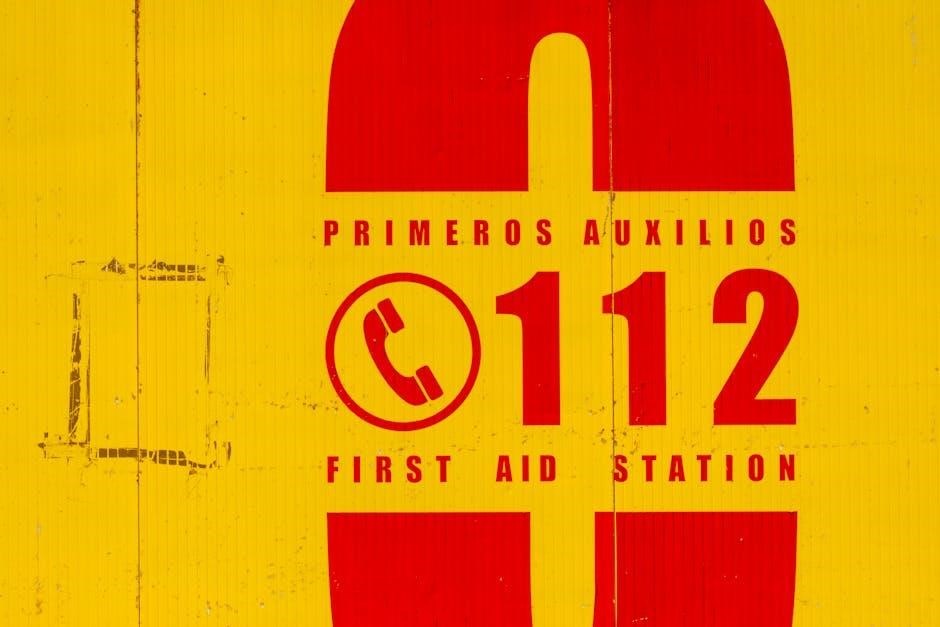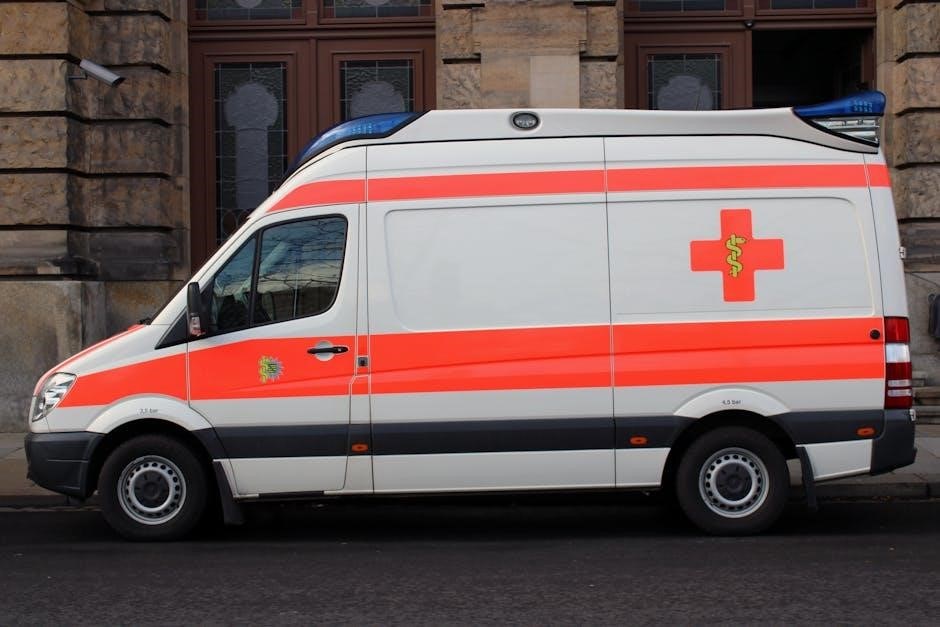canadian red cross first aid test questions and answers pdf

Overview of Canadian Red Cross First Aid Certification
The Canadian Red Cross First Aid Certification is a comprehensive program offering life-saving skills and knowledge․ It includes written and practical exams, covering essential topics like CPR, choking, and burns․ The certification is widely recognized and regularly updated to reflect current medical guidelines, ensuring participants are well-prepared to respond confidently in emergencies․ Resources like PDF guides and practice exams are available to aid preparation, making it a trusted choice for gaining critical first aid skills․
Importance of First Aid Training
First aid training is crucial for empowering individuals to act confidently during medical emergencies․ It equips learners with essential skills to save lives, reduce injury severity, and provide care until professional help arrives․ Knowledge of CPR, choking relief, and wound care can significantly improve outcomes in critical situations․ The Canadian Red Cross emphasizes that first aid training fosters a safer community by enabling individuals to respond effectively․ Regular updates to the curriculum ensure that participants receive evidence-based, modern techniques․ Accessible to all, this training promotes preparedness and reduces panic in emergencies, making it a vital skill for everyone․
- Builds confidence to act in life-threatening situations․
- Empowers individuals to save lives and prevent further harm․
- Encourages a proactive approach to community safety․
Structure of the Certification Program
The Canadian Red Cross First Aid Certification program is structured to provide a comprehensive learning experience, blending theoretical knowledge with practical skills․ The program is divided into modules, each focusing on specific aspects of first aid, such as emergency assessment, CPR, and wound care․ Participants engage in both written and practical exams to demonstrate their understanding and ability to apply first aid techniques․ Instructors guide learners through hands-on training sessions, ensuring proficiency in critical skills; The program is designed to accommodate various learning styles, offering resources like PDF guides and online quizzes to supplement in-person training․ This structured approach ensures that graduates are well-prepared to respond confidently in real-world emergencies․
- Combines theoretical and practical learning․
- Includes hands-on training and scenario-based practice․
- Offers flexible resources for self-study and reinforcement․

Exam Structure and Requirements
The Canadian Red Cross First Aid exam consists of a written examination with multiple-choice questions and a practical skills demonstration․ Candidates must pass both sections to earn certification․
Written Examination: Multiple-Choice Questions
The written examination for the Canadian Red Cross First Aid Certification consists of multiple-choice questions that assess theoretical knowledge․ These questions cover essential topics such as Good Samaritan Laws, emergency action steps, and CPR techniques․ Candidates are required to answer correctly to demonstrate their understanding of first aid principles․ The questions are designed to evaluate critical thinking and the ability to apply knowledge in real-life scenarios․ Preparation materials, including PDF study guides and online practice exams, are available to help candidates familiarize themselves with the exam format and content․ Successfully completing the written exam is a crucial step toward obtaining the certification․
Practical Examination: Skills Demonstration
The practical examination for the Canadian Red Cross First Aid Certification requires candidates to demonstrate their ability to perform first aid skills effectively․ This hands-on assessment evaluates techniques such as CPR, bleeding control, and wound care․ Candidates must accurately perform these skills in simulated emergency scenarios, showcasing their readiness to respond confidently in real-life situations․ The practical exam is a critical component of the certification process, ensuring that participants can apply their knowledge safely and correctly․ Preparation for this section involves practicing skills regularly and reviewing the Canadian Red Cross First Aid Handbook․ Successful completion of both the written and practical exams is required to obtain the certification․

Key Topics Covered in the Exam
The exam covers essential first aid skills, including cardiopulmonary resuscitation (CPR), choking relief, wound care, and burns․ It also addresses emergency response steps and airway management techniques․
Good Samaritan Laws and Consent
Understanding Good Samaritan Laws is crucial for first aid responders, as they protect individuals providing aid in emergencies from legal liability, ensuring they act in good faith without negligence․ These laws encourage bystanders to assist without fear of legal consequences, promoting timely intervention․ Consent is another key topic, emphasizing the importance of obtaining permission before providing care, except in life-threatening situations where it’s implied․ The curriculum also covers scenarios where consent may not be possible, such as with unconscious individuals, to ensure responders act ethically and legally․ These principles are vital for ethical first aid practice and are thoroughly tested in the certification exam to ensure responders are well-prepared and informed․
Emergency Action Steps and Assessment
Emergency action steps and assessment are critical components of first aid training, focusing on quick decision-making to ensure safety and effective care․ The process begins with ensuring the scene is safe for both the responder and the individual in need․ Assessing the person’s condition involves checking for responsiveness, airway, breathing, and circulation (ABCs)․ The “Look, Listen, and Feel” method is taught to determine if a person is breathing normally․ These steps guide immediate care, such as calling for help, providing rescue breaths, or starting CPR if necessary․ Proper assessment ensures timely interventions, preventing further harm․ These principles are emphasized in certification exams and study materials, preparing responders to act confidently in real-life emergencies․ Mastery of these steps is essential for providing effective first aid․
Cardiopulmonary Resuscitation (CPR) Techniques
CPR techniques are a cornerstone of first aid training, emphasizing chest compressions and rescue breaths to maintain blood circulation and oxygenation․ The Canadian Red Cross teaches the C-A-B (Compression, Airway, Breathing) sequence, starting with 30 chest compressions at a rate of 100-120 per minute․ Proper hand placement on the lower half of the sternum is crucial․ Rescue breaths are provided after every 30 compressions, ensuring the chest rises visibly․ Automated External Defibrillators (AEDs) are integrated into CPR training, with prompts guiding users to deliver shocks if necessary․ Effective CPR can double a person’s chance of survival from cardiac arrest․ Practice and mastery of these techniques are essential, as highlighted in certification exams and study materials, to ensure confident and correct application in emergencies․

Preparation Resources
Access PDF study guides and answer keys for comprehensive exam preparation․ Utilize online practice exams and Quizlet flashcards to master first aid and CPR techniques effectively before your certification test․
PDF Study Guides and Answer Keys
The Canadian Red Cross provides PDF study guides and answer keys to help candidates prepare for their certification exams․ These resources are accessible through the MyRC Profile under the Tools section and are specifically designed for first aid programs․ The guides cover essential topics such as cardiopulmonary resuscitation (CPR), choking procedures, and wound care, ensuring a thorough understanding of the material․ Answer keys are included to allow self-assessment and identification of areas needing improvement․ These PDF materials are a valuable tool for reviewing and practicing exam questions, helping candidates feel confident and well-prepared for both the written and practical exams․ Regularly updating these guides ensures alignment with the latest first aid and CPR guidelines․
Online Practice Exams and Quizzes
Online practice exams and quizzes are essential tools for preparing for the Canadian Red Cross First Aid Certification․ These resources, available through platforms like Quizlet and the MyRC Profile, offer interactive ways to test knowledge and readiness․ Practice exams typically include multiple-choice questions covering topics such as emergency action steps, CPR techniques, and wound care․ Quizzes focus on specific skills, like identifying Good Samaritan laws or understanding consent procedures․ Many resources are mobile-friendly, allowing candidates to study anytime, anywhere․ Flashcards and scenario-based questions further enhance learning by reinforcing key concepts and practical applications․ Regular use of these tools ensures confidence and proficiency in both written and practical exams, helping candidates master life-saving skills effectively․ Utilizing these online resources is a proven way to achieve success in the certification process․

Common Medical Emergencies
Common medical emergencies include choking, burns, and cardiac issues․ Immediate response is crucial to prevent complications․ Training covers assessment and care for these life-threatening situations effectively․
Choking and Airway Obstruction
Choking and airway obstruction are critical emergencies requiring immediate action․ The Canadian Red Cross emphasizes the importance of recognizing signs such as clutching the throat, inability to speak, and blue discoloration․ For adults and children, back slaps are administered to dislodge the object․ If unsuccessful, abdominal thrusts are performed․ Infants require chest thrusts․ If the victim becomes unconscious, CPR must be initiated․ Proper training is essential to prevent complications․ Practice materials, including PDF guides, cover these scenarios in detail, ensuring responders are confident and skilled in managing choking incidents effectively․
Burns and Wound Care
Burns and wound care are essential skills in first aid, focusing on preventing infection and promoting healing․ The Canadian Red Cross teaches to cool burns with cool water for 10-15 minutes and assess severity based on depth and size․ Minor burns are treated with topical creams, while severe burns require immediate medical attention․ Wounds should be cleaned with sterile water and covered to prevent contamination․ Proper dressing and bandaging techniques are emphasized to protect injuries․ Training materials, including PDF guides, provide detailed steps for managing burns and wounds effectively, ensuring responders can act confidently in emergencies․
Cardiac Emergencies and AED Use
Cardiac emergencies, such as heart attacks and cardiac arrests, require immediate action to save lives․ The Canadian Red Cross emphasizes the importance of rapid response, as delays can drastically reduce survival chances․ Automated External Defibrillators (AEDs) are critical tools in these situations․ Training includes recognizing signs of cardiac distress, performing CPR, and properly using an AED․ Participants learn to assess the situation, call for emergency services, and apply AED pads correctly․ The curriculum also covers when and how to administer chest compressions․ Resources like PDF guides and practice exams help reinforce these life-saving skills, ensuring responders can act confidently and effectively during cardiac emergencies․

Additional Training and Updates
The Canadian Red Cross regularly updates its first aid programs, including opioid poisoning response and specialized training initiatives․ These updates ensure participants receive the latest, evidence-based techniques and guidelines․
Opioid Poisoning Response
The Canadian Red Cross has integrated opioid poisoning response into its first aid and CPR programs․ This training focuses on recognizing symptoms of opioid overdose, such as unresponsiveness, slow or absent breathing, and blue-tinged skin or lips․ Participants learn how to administer naloxone, a life-saving medication that reverses opioid effects, and provide care until medical help arrives․ The program emphasizes the importance of acting quickly, as delays can lead to severe brain damage or death․ Practical scenarios and hands-on training ensure participants are confident in their ability to respond effectively․ This update reflects the growing need for community-based solutions to the opioid crisis, equipping individuals with critical skills to save lives during emergencies․
Specialized Training Programs
The Canadian Red Cross offers specialized training programs tailored to specific needs and industries․ For instance, motorcyclists can benefit from the Biker Down program, a unique certification focused on motorcycle-related injuries․ This program teaches riders how to respond to crashes, including helmet removal and spinal immobilization․ Other specialized programs cater to workplace first aid, marine environments, and remote or wilderness settings; These courses are designed to address unique challenges and risks in these contexts․ Participants receive tailored instruction, including hands-on practice and scenario-based training, to build confidence and competence․ Resources like PDF guides and practice quizzes support these programs, ensuring learners are well-prepared for emergencies specific to their environments or activities․

Accessing Study Materials
Access study materials through the MyRC Profile Tools section, including PDF guides, online practice exams, and Quizlet flashcards․ These resources help effectively prepare for the certification exam․
MyRC Profile and Tools Section
The MyRC Profile and Tools Section is a centralized hub for accessing Canadian Red Cross First Aid study materials․ Through this platform, participants can download PDF study guides, access written exams, and review answer keys specific to their certification program․ These resources are tailored to help candidates prepare effectively for both the written and practical components of the exam․ Additionally, the MyRC Profile provides access to interactive tools and practice exams, ensuring a comprehensive understanding of first aid principles and techniques․ The platform is user-friendly, allowing individuals to track their progress and identify areas for improvement․ By leveraging these resources, candidates can confidently approach their certification exam and develop the skills needed to respond to real-life emergencies․

Flashcards and Quizlet Resources
Flashcards and Quizlet resources are invaluable tools for preparing for the Canadian Red Cross First Aid exam․ These resources provide interactive and engaging ways to memorize key terms, concepts, and procedures․ Quizlet offers flashcards covering topics such as Good Samaritan laws, consent, emergency action steps, and CPR techniques․ Additionally, users can access multiple-choice questions and practice exams to test their knowledge․ The flashcards are organized into sets, such as a 20-term set focusing on fundamental principles and scenarios․ These tools are designed to complement traditional study materials, allowing learners to reinforce their understanding of critical first aid skills in a dynamic and accessible format․ Regular use of these resources can significantly enhance exam readiness and retention of life-saving information․

Final Preparation Tips

Review the handbook thoroughly, focusing on key concepts like emergency steps and CPR techniques․ Practice practical skills and scenarios to build confidence and ensure readiness for the exam․
Reviewing the Handbook
Thoroughly reviewing the Canadian Red Cross First Aid handbook is essential for success․ The handbook covers critical topics such as emergency action steps, CPR techniques, and Good Samaritan laws․ It also includes detailed sections on assessing patients, managing injuries, and responding to cardiac emergencies․ Pay close attention to diagrams and examples that illustrate proper first aid procedures․ The handbook aligns with the exam questions, ensuring you understand key concepts․ Regularly revisit the material to reinforce learning and address any areas of confusion․ By mastering the handbook, you’ll feel more confident in your ability to apply first aid skills effectively during the exam and in real-life situations․
Practicing Skills and Scenarios
Practicing first aid skills and scenarios is crucial for mastering the Canadian Red Cross certification․ Regular hands-on practice helps build confidence and ensures readiness in real-life emergencies; Focus on key skills like CPR, choking relief, and wound care, repeating drills until they become second nature․ Use training materials, such as mannequins or simulated wounds, to mimic real-life conditions․ Scenario-based training, like responding to burns or cardiac arrests, enhances decision-making under pressure․ The more you practice, the more intuitively you’ll perform during the exam and in actual emergencies․ Additionally, role-playing different emergency roles helps refine communication and teamwork skills, making you a more effective first aider․ Consistent practice ensures you’re prepared to act decisively and correctly when it matters most․